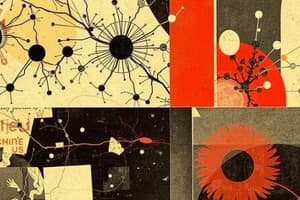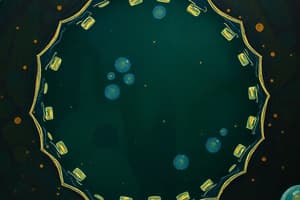Podcast
Questions and Answers
What is the diploid number represented as?
What is the diploid number represented as?
- 2n (correct)
- X
- 3n
- n
During which stage of mitosis do chromosomes become visible?
During which stage of mitosis do chromosomes become visible?
- Telophase
- Metaphase
- Prophase (correct)
- Anaphase
What is the main action taking place during anaphase?
What is the main action taking place during anaphase?
- Cytokinesis begins
- Sister chromatids are pulled apart (correct)
- Nuclear envelope reforms
- Chromosomes align in the center
Which structure assists in separating sister chromatids during anaphase?
Which structure assists in separating sister chromatids during anaphase?
What occurs during telophase of mitosis?
What occurs during telophase of mitosis?
What happens in cytokinesis for animal cells?
What happens in cytokinesis for animal cells?
How do plant cells perform cytokinesis?
How do plant cells perform cytokinesis?
What is the role of gametes in relation to chromosome numbers?
What is the role of gametes in relation to chromosome numbers?
What is the role of cyclins during the M phase of the cell cycle?
What is the role of cyclins during the M phase of the cell cycle?
Which of the following statements accurately describes apoptosis?
Which of the following statements accurately describes apoptosis?
Which component is responsible for regulating apoptosis by keeping caspases in check?
Which component is responsible for regulating apoptosis by keeping caspases in check?
How do Ras proteins contribute to cellular growth?
How do Ras proteins contribute to cellular growth?
During which phase do chromosomes condense into their observable form with sister chromatids?
During which phase do chromosomes condense into their observable form with sister chromatids?
What is the role of histone proteins in the structure of chromosomes?
What is the role of histone proteins in the structure of chromosomes?
In the context of chromosomes, what does the term 'diploid' refer to?
In the context of chromosomes, what does the term 'diploid' refer to?
What occurs during the S phase of interphase?
What occurs during the S phase of interphase?
What are proto-oncogenes primarily responsible for in cellular activity?
What are proto-oncogenes primarily responsible for in cellular activity?
What happens to proto-oncogenes when they acquire mutations?
What happens to proto-oncogenes when they acquire mutations?
Which of the following genes is primarily involved in inhibiting the cell cycle?
Which of the following genes is primarily involved in inhibiting the cell cycle?
Which statement about tumor suppressor genes is correct?
Which statement about tumor suppressor genes is correct?
The RB gene is known for its involvement in which of the following cancers?
The RB gene is known for its involvement in which of the following cancers?
What is a common effect of mutations in the ras gene family?
What is a common effect of mutations in the ras gene family?
Which function is NOT associated with tumor suppressor genes?
Which function is NOT associated with tumor suppressor genes?
How many potential oncogenes are estimated to exist?
How many potential oncogenes are estimated to exist?
What is the primary purpose of the G1 checkpoint in the cell cycle?
What is the primary purpose of the G1 checkpoint in the cell cycle?
Which protein is associated with regulating the transition from G1 to S stage in response to growth signals?
Which protein is associated with regulating the transition from G1 to S stage in response to growth signals?
What happens to the RB protein when nutrient levels are insufficient?
What happens to the RB protein when nutrient levels are insufficient?
What role does p53 play in the G1 checkpoint regarding DNA damage?
What role does p53 play in the G1 checkpoint regarding DNA damage?
How does the cell cycle respond when DNA damage is repaired?
How does the cell cycle respond when DNA damage is repaired?
In the context of cell division, what is a potential consequence of insufficient growth signals?
In the context of cell division, what is a potential consequence of insufficient growth signals?
Which component is NOT involved in the signaling pathway that determines cell division at the G1 checkpoint?
Which component is NOT involved in the signaling pathway that determines cell division at the G1 checkpoint?
What triggers the p53 protein to increase during the G1 checkpoint assessment?
What triggers the p53 protein to increase during the G1 checkpoint assessment?
What is the role of the p53 gene in cancer suppression?
What is the role of the p53 gene in cancer suppression?
How does p53 contribute to the cell cycle regulation?
How does p53 contribute to the cell cycle regulation?
What is the effect of activated caspases in cells?
What is the effect of activated caspases in cells?
What happens to telomeres during cell division without the action of telomerase?
What happens to telomeres during cell division without the action of telomerase?
Which of the following best describes binary fission?
Which of the following best describes binary fission?
What distinguishes prokaryotic cell division from eukaryotic cell division?
What distinguishes prokaryotic cell division from eukaryotic cell division?
What is one consequence of DNA repair systems failing?
What is one consequence of DNA repair systems failing?
BRCA1 and BRCA2 are primarily classified as what type of gene?
BRCA1 and BRCA2 are primarily classified as what type of gene?
Flashcards are hidden until you start studying
Study Notes
Cell Cycle Control
- G1 Checkpoint: Evaluates cell's readiness to commit to division by assessing growth signals, nutrient availability, and DNA integrity.
- Growth Signals: Hormones from nearby or distant tissues trigger signal transduction pathways leading to G1 progression.
- Growth factors activate CDKs (cyclin-dependent kinases), which phosphorylate RB protein.
- Phosphorylated RB releases E2F protein, activating genes needed for cell cycle progression.
- Nutrient Availability: Adequate nutrients are essential for continued cell cycle progression.
- Insufficient nutrients prevent RB phosphorylation, blocking E2F release and halting cell cycle progression.
- DNA Integrity: Ensures accurate transmission of genetic information.
- DNA damage activates CDKs to phosphorylate p53 protein, which binds to DNA and activates DNA repair proteins.
- If damage is irreparable, p53 levels increase, eventually triggering apoptosis.
- Growth Signals: Hormones from nearby or distant tissues trigger signal transduction pathways leading to G1 progression.
Apoptosis
- Programmed cell death that helps maintain normal cell levels in somatic cells, preventing tumor development.
- Caspases, enzymes responsible for apoptosis, are normally held in check by inhibitors.
- Internal or external signals deactivate inhibitors, leading to activation of caspases and cell death.
Chromosome Structure
- Chromatin: DNA and associated proteins that condense into chromosomes during cell division.
- Nucleosomes: DNA wrapped around histone protein spools, forming the basic unit of chromatin.
- Chromosomes: Condensed chromatin during mitosis, consisting of two sister chromatids joined by a centromere.
- Interphase: DNA is uncoiled and replicated during the S phase, but chromosomes are not visible.
- Mitotic Stage: Chromosomes become visible as doubled sister chromatids.
Mitosis
- Cell division producing two genetically identical daughter cells.
- Prophase: Chromosomes condense, nuclear envelope breaks down, and spindle fibers form.
- Metaphase: Chromosomes align at the metaphase plate, guided by spindle fibers.
- Anaphase: Sister chromatids separate and move to opposite poles of the cell.
- Telophase: Nuclear envelope reforms, chromosomes decondense, and cytokinesis begins.
Cytokinesis
- Division of the cytoplasm into two distinct daughter cells.
- Animal Cells: Cleavage furrow indents the plasma membrane, pinching off the two cells.
- Plant Cells: Cell plate forms between daughter cells, eventually becoming a cell wall.
Cancer Development
- Proto-oncogenes: Genes that promote cell cycle progression and inhibit apoptosis (like the gas pedal).
- Mutations in proto-oncogenes convert them to oncogenes, increasing cell division and promoting cancer.
- Examples: ras gene family, WNT, MYC, ERK, TRK (do not memorize all, just for understanding).
- Tumor Suppressor Genes: Genes that inhibit cell cycle progression and promote apoptosis (like the brakes).
- Mutations in tumor suppressor genes can disrupt these functions, promoting uncontrolled cell growth.
- Examples: RB (retinoblastoma), P53, BRCA1, BRCA2 (do not memorize all, just for understanding).
Other Cancer Origins
- DNA repair systems: Failure to repair DNA damage can lead to mutations and uncontrolled cell growth.
- Telomeres: Ends of chromosomes that normally shorten with each replication.
- Telomerase: An enzyme that prevents telomere shortening, allowing cells to divide indefinitely.
- Cancer cells often express telomerase, contributing to their uncontrolled proliferation.
Prokaryotic Cell Division
- Prokaryotic Chromosome: Single, circular chromosome located in the nucleoid region.
- Binary Fission: Asexual reproduction in prokaryotes, where the chromosome replicates, the cell elongates, and divides into two identical daughter cells.
Comparing Prokaryotic and Eukaryotic Cell Division
| Organism | Cell Division | Function |
|---|---|---|
| Prokaryotes (bacteria & archaea) | Binary Fission | Asexual reproduction |
| Eukaryotes (protists & some fungi) | Mitosis & cytokinesis | Asexual reproduction |
| Eukaryotes (other fungi, plants, animals) | Mitosis & cytokinesis | Development, growth, and repair |
Studying That Suits You
Use AI to generate personalized quizzes and flashcards to suit your learning preferences.




